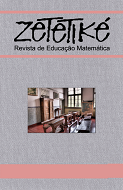Resumo
Este artigo apresenta e discute resultados de uma pesquisa que teve como objetivo compreender as estratégias e o que estas revelam sobre a criatividade dos alunos em atividades de formulação e solução de problemas do discurso matemático escolar. Está ancorada na Teoria Comognitiva, que considera a matemática um discurso, na Perspectiva de Sistemas, para o qual a ação criativa não ocorre de forma isolada, mas da relação entre três sistemas: indivíduo, domínio e campo, bem como na verificação de como os alunos manifestam elementos da criatividade nas suas produções em relação à Flexibilidade e Originalidade. É uma pesquisa de abordagem qualitativa, desenvolvida com alunos dos anos finais do Ensino Fundamental de escola pública do município de Canaã dos Carajás no Estado do Pará. Para a produção de dados foram aplicadas atividades que demandavam dos alunos formulação de problemas e solução de problemas. Os resultados da pesquisa apontam para a ocorrência de manifestação criativa em relação à flexibilidade e originalidade em rotinas de exploração, ato e ritual.
Referências
Aiken, L. R. (1973). Ability and creativity in mathematics. Review of Educational Research, 43(4), 405-432. https://doi.org/10.2307/1170074
Amaral, N. A. R. (2016). A criatividade matemática no contexto de uma competição de resolução de problemas. Tese de Doutorado em Educação. Lisboa: Universidade de Lisboa. Retirado em 12 de agosto, 2020, de: http://hdl.handle.net/10451/24861
Bogdan, R. C., & Biklen, S. K. (1982). Qualitative research for educativon. Boston: allyn and Bacon, inc.
Csikszentmihalyi, M. (1998). Creatividad: El fluir y la psicologia de descubrimiento u la invención. Tradução: José Pedro Tosaus Adadia. Barcelona: Paidós Transiciones.
Ervynck, G. (1991). Mathematical creativity. In. D. Tall (Org.), Advanced mathematical thinking (pp. 42-53). Boston: Kluwer Academic.
Fonseca, M. G. (2015). Construção e validação de instrumento de medida de criatividade no campo da matemática para estudantes concluintes da educação básica. [Dissertação de Mestrado em educação]. Brasília: Universidade de Brasília. Retirado em 10 de agosto, 2020, de: https://repositorio.unb.br/handle/10482/20203
Gontijo, C. H. (2006). Estratégias para o desenvolvimento da criatividade em matemática. Linhas Críticas, 12(23), 229-244. https://doi.org/10.26512/lc.v12i23.3321
Gontijo, C. H. (2007). Relações entre criatividade, criatividade em matemática e motivação em matemática de alunos do ensino médio. [Tese de Doutorado em Psicologia]. Brasília: Universidade de Brasília. Retirado em 19 de agosto, 2020, de https://repositorio.unb.br/handle/10482/2528
Gontijo, C. H., Silva, E. B., & Carvalho, R. P. F. (2012). A Criatividade e as Situações Didáticas no Ensino e Aprendizagem de Matemática. Linhas Críticas, 18 (35), 29-46. Disponível em: http://www.redalyc.org/articulo.oa?id=193523804004
Hadamard, J. (1954). The psychology of invention on the mathematical field. Dover: New York.
INEP (2021). Programa Internacional de Avaliação de Alunos (PISA). Brasília: Retirada em 16 de junho, 2022, de: https://www.gov.br/inep/pt-br/areas-deatuacao/avaliacao-e-exames-educacionais/pisa
Lima, V. S. (2001). Solução de problemas: habilidades matemáticas, flexibilidade de pensamento e criatividade. Tese de Doutorado em Educação. Campinas: Universidade Estadual de Campinas. Retirada em 4 de agosto, 2020, de: http://repositorio.unicamp.br/jspui/handle/REPOSIP/253525
Ministério da Educação (2018). Base Nacional Comum Curricular (BNCC). Brasília: MEC. Retirado em 01 de novembro, 2019, de: http://basenacionalcomum.mec.gov.br/images/BNCC_EI_EF_110518_versaofinal_site.pdf
Sfard, A. (2008). Thinking as communicating: human development, the growth of discourses, and mathematizing. Cambridge: Cambridge University Press.
Sternberg, R. J. (2001). What is the common thread of creativity? Its dialectical relation to intelligentand wisdom. American Psychologist, 56 (4), 360-362. https://doi.org/10.1037/0003-066X.56.4.360
Wallas, G. (1973). The art of thought. Em P. E. Vernon (Org.), Creativity (pp. 91-97).
Harmondsworth, UK: Penguin (trabalho original publicado em 1926).

Este trabalho está licenciado sob uma licença Creative Commons Attribution-NonCommercial-NoDerivatives 4.0 International License.
Copyright (c) 2023 Zetetiké


